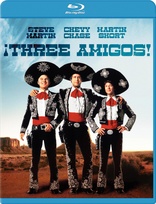íThree Amigos! Blu-ray Movie
HomeíThree Amigos! Blu-ray Movie 
25th Anniversary EditionHBO | 1986 | 103 min | Rated PG | Nov 22, 2011
Movie rating
7 | / 10 |
Blu-ray rating
| Users | 3.1 | |
| Reviewer | 4.5 | |
| Overall | 3.8 |
Overview
íThree Amigos! (1986)
When a villainous bandit terrorizes her small Mexican village, a real-life damsel in distress enlists the help of three goofy singing cowboy Hollywood stars--mistakenly believing that they are as heroic in person as they are onscreen. The wimpy actors think they are going south of the border to perform a one-time show for a large fee. As they arrive in the tiny oppressed village, they begin to realize that they are caught in a horrible case of mistaken identity and must truly fight for their lives against the evil marauder El Guapo. They cowardly run for their lives while the village is almost destroyed until they realize the importance of their mission and are forced to use real cunning and bravery to try to defeat the villain's hordes in order to prove that the Three Amigos are as truly as courageous and heroic as they appeared onscreen.
Starring: Steve Martin, Chevy Chase, Martin Short, Alfonso Arau, Tony PlanaDirector: John Landis
| Comedy | 100% |
| Western | 14% |
| Adventure | Insignificant |
Specifications
Video
Video codec: MPEG-4 AVC
Video resolution: 1080p
Aspect ratio: 1.85:1
Original aspect ratio: 1.85:1
Audio
English: DTS-HD Master Audio 5.1 (48kHz, 24-bit)
French: DTS 2.0
Spanish: DTS 2.0 Mono
Subtitles
English SDH, French, Spanish
Discs
25GB Blu-ray Disc
Single disc (1 BD)
Playback
Region A (locked)
Review
Rating summary
| Movie | 5.0 | |
| Video | 4.5 | |
| Audio | 4.0 | |
| Extras | 4.0 | |
| Overall | 4.5 |
íThree Amigos! Blu-ray Movie Review
Play, Very Blu One, Play Like the Wind!
Reviewed by Michael Reuben November 14, 2011If Harry Flugleman, the maniacal studio head played by Joe Mantegna in íThree Amigos!, had been the executive in charge, everyone involved would have been thrown into the street. But who could have expected a flop? Steve Martin and Chevy Chase were big comedy stars at the time, and Martin Short was familiar from TV. Director John Landis still had comic credibility from Animal House, The Blues Brothers, Trading Places and even Spies Like Us -- and once again he was working with talented alumni from Saturday Night Live. Maybe it was the curse of the Western. As Landis recalls in the Empire magazine reunion interview included with the Blu-ray, people warned him not to make a Western, because they were passÚ. Lawrence Kasdan told Landis that the same sages warned him not to make Silverado (and a few years later they probably told Kevin Costner not to make Dances with Wolves, Billy Crystal not to make City Slickers and Clint Eastwood not to make Unforgiven). Certainly audiences coming to see a comic Western from the director of Animal House were probably expecting something broad and rude, the kind of parody that Mel Brooks delivered twelve years earlier in Blazing Saddles, with cowpokes siting around the campfire farting and Alex Karras punching a horse unconscious. íThree Amigos! was just as silly a film, but in a different way. For starters, the whole notion of movie star cowboy heroes mistaken for the real thing has a self-conscious, ironic dimension that, in 1986, was ahead of its time. (As Steve Martin points out, 1999's Galaxy Quest repeated the same plot to great success. But Galaxy Quest was working with an obsessive sci-fi fan culture in which confusing entertainment with reality was already a running joke.) And the rest of íThree Amigos! takes it cue from that winking, can-you-believe-this premise. The film's villain, El Guapo, may threaten rape and pillage, and he actually does order the destruction of a town, but he's chiefly remembered for being vain about his age and quizzing his chief lieutenant about a "plethora" of pi˝atas. Like the heros of the title and their adventures, El Guapo is a "bad guy" in air quotes. Except for the few early converts who laughed out loud on the first viewing (and you know who you are), íThree Amigos! built its fan base over time, because its jokes are the kind that get funnier with repetition. Until now, though, the cruelest joke of all was the lack of any decent version on home video. The DVD released by HBO in 1999 was an embarrassment: non-anamorphic, afflicted by massive gate-weave throughout the running time, and improperly mastered so that it abruptly ceased to play during the credits. The new Blu-ray, overseen by director Landis, immediately becomes the new standard version of íThree Amigos!, visually and sonically, and it also contains new extras that provide valuable information about the film.
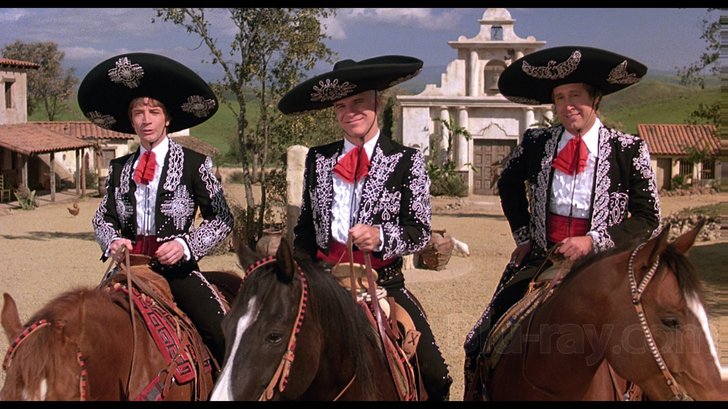
In 1916, the peaceful Mexican village of Santa Poco is being terrorized by the dastardly El Guapo (Alfonso Arrau) and his band of hoodlums. A plucky young woman, Carmen (Patrice Martinez), accompanied by her brother, Rodrigo (Philip Gordon), seeks help in a nearby town but finds only more scum like El Guapo. But then Carmen and Rodrigo hear the sound of organ music from the nearby church and enter to see a silent film being projected. It's the Three Amigos: Lucky Day (Martin), Dusty Bottoms (Chase) and Ned Nederlander (Short), heroic defenders of the weak and upholders of justice. Carmen and Rodrigo think they're watching a newsreel recounting true exploits and immediately telegraph the Three Amgios (c/o Goldsmith Studios) to ride to their aid. As it happens, the Amigos need a gig. They've just been fired by studio boss Flugleman (Mantegna) for demanding more money when their last picture, Those Darn Amigos, flopped at the box office. Ejected from the studio mansion, stripped of their clothes (all of which came from wardrobe), they're standing outside the gates when Carmen's telegram arrives. All they have to do is steal their costumes from wardrobe and head off to Mexico. (If the costumes remind you of the 1950s TV series The Cisco Kid, it's because the Amigos are supposed to be wealthy Spanish landowners, who fight crime and injustice in their spare time. The rest of the cast in their black-and-white faux silent movies look no more Hispanic than Chase, Martin and Short.) For a while, the Amigos are able to maintain the illusion that they're lethal killers through a case of mistaken identity. Without realizing it, they cross paths with a German arms dealer (Kai Wulff) and are mistaken for his associates, even while performing a fey rendition of "My Little Buttercup". Eventually, though, illusion and reality collide, and the Amigos are unmasked as actors. "El Guapo only kills men!" says the brigand, as he sends the weeping trio scurrying for their lives. Distraught, ashamed and aware that they have nothing to go back to, the trio decides to do the absurd and be the Three Amigos for real. Like Alan Swann in My Favorite Year, they'll save the day -- for real. It may be a little late, since El Guapo has decimated Santa Poco and kidnapped Carmen, but better late than never. One of íThree Amigos! most subversive running gags is that, from the moment Lucky, Dusty and Ned commit to being "real" heros, the movie itself promptly gets more artificial. How else to explain that the villagers' directions to El Guapo's lair involve finding a singing bush (voiced by Randy Newman -- it's in the credits) and summoning an Invisible Swordsman? What about that scene where they sleep under the stars against a beautiful but very obviously painted backdrop, with flat cardboard cactuses, trained and well-behaved animals, singing horses and a talking tortoise? And let's not forget Lucky's miraculous ability to recover from bullet wounds, Ned's flying skills, speed-sewing that even a modern factory would envy and the miraculous appearance in Santa Poco of a large cache of weapons that, if it had been there earlier, would have rendered outside help a moot point. Indeed, by the time the Amigos ride out of Santa Poco into a purple sunset, their entire Mexican adventure seems to have been converted into a Harry Flugleman release, just fast-forwarded a few decades to the age of talkies and technicolor. Which may be the biggest joke of all. Landis has always worked best with comedy ensembles, and he coordinated the different styles of the trio playing the Amigos with a master's skill. (In the accompanying interview, they all agree that Landis was the one in charge.) All three are playing dumb, but in very specific versions: Martin's Lucky, the assertive ignoramus who thinks he knows what he's doing when he hasn't a clue; Chase's Dusty, the narcissistic klutz who doesn't want to be bothered with anything that requires effort or thought ("You could kiss me on the veranda." "Lips would be fine."); and Short's Ned, a child star who never grew up and for whom life is a movie. Still, the most memorable comic creation may be Alfonso Arau's El Guapo. As much as the film's plot owes to The Magnificent Seven (or its source, The Seven Samurai), Arau's presence attests to an additional source, The Wild Bunch, where Arau played one of the lesser villains and managed to stand out, even at a tender age, while confronting a stony-faced William Holden. (It's hard to imagine anyone else saying "please . . . cut the fuse" with quite the same urgency.) As in The Wild Bunch, the villain is being aided by German armorers, but El Guapo has no political ambition. He just wants to enjoy being El Guapo, which is how Arau plays him. When you're El Guapo, life is a pi˝ata of pleasures -- until gringos start falling from the sky.
íThree Amigos! Blu-ray Movie, Video Quality 
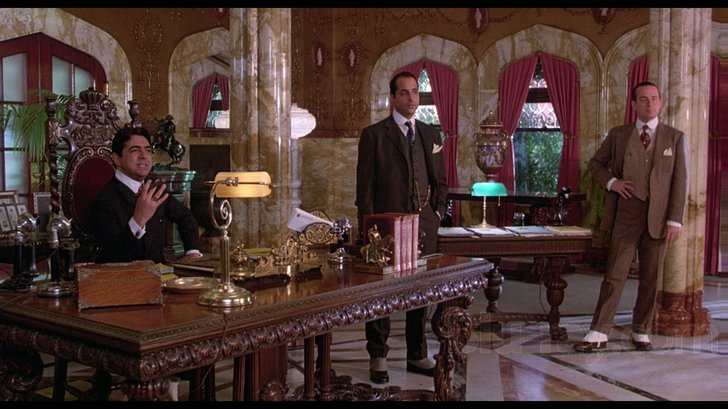
With one small reservation, which I'll discuss below, HBO's Blu-ray of íThree Amigos! presents the film as it was meant to be seen and more than makes up for the 1999 DVD travesty. Gone is the pervasive gate-weave and print damage, and the credits play to the end. The 1080p, AVC-encoded image features strong, saturated colors that shift as appropriate to portray the scene on display, whether it's the dusty earth tones of Santa Poco and El Guapo's hideout, the Hollywood tackiness of the Goldsmith studio, the purplish hues of the sunsets into which the Amigos ride (several times) or the soundstage technicolor prairie on which the Amigos camp, dining on barbecued bat (actually bacon). Even the parched desert crossing is colorful without being blown out by the hot whites of the sand and sun. Black levels are very good, and they need to be, or the Amigos' costumes wouldn't look right. Detail is so well delineated that the hideous patterns of the outfits the Amigos wear to their Flugleman meeting (costumes they inherited from their flop, Those Darn Amigos) are on full display. The dirt, grime and bad teeth of El Guapo and his men are also conveyed in suitably grotesque detail, along with the stitching and spangles on the Amigos' costumes. My only reservation is one that I hesitate to bring up, because of the likelihood that it will be taken out of context and magnified to the exclusion of this Blu-ray's virtues (and I'm giving it a high score). There is almost a complete absence of visible film grain, which is surprising in a film of this vintage. Every so often -- and we're talking about a handful of shots in the entire film -- a close-up on one of the Amigos' faces left me with the impression that the texture was a little too smooth. I'm not talking about a "wax dummy" effect (a phenomenon that I suspect Landis is all too familiar with, given what Paramount did to his Trading Places); it's more like the effect of too much pancake makeup. We have reached the point in the development of digital tools where it is possible to effectively eliminate film grain without stripping image detail; a recent impressive example is James Cameron's Aliens. However, just because an ability exists doesn't mean it has to be used. The decision whether or not to eliminate grain is an aesthetic, even a philosophical one. Obviously, it may also have commercial implications. For whatever combination of reasons, Landis and the technical staff he was overseeing appear to have made the decision to produce a grainless íThree Amigos!, and they have certainly done it the right way: leaving the full range of picture information intact and introducing no artifacts that I could detect. Indeed, judged by the standards of today's digital intermediate world, where grain is frequently non-existent in the final product, this is a pleasantly film-like image, and it certainly lacks the digital "edge" that has marred Blu-rays such as Back to the Future. I've already devoted more words to this issue than a non-problem deserves, but since it caught my eye, I couldn't say nothing. And since it's a subject that can't be raised without risking battles over lines in the sand (much like the one Ned draws), I'm taking this opportunity to articulate my observations in full before recommending the disc.
íThree Amigos! Blu-ray Movie, Audio Quality 
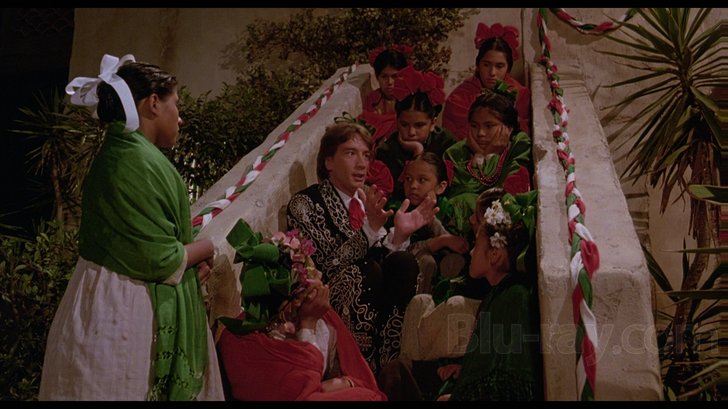
The film and DVD were released in stereo, but the Blu-ray's soundtrack is offered in 5.1 mastered in DTS lossless. The track remains front-centered, although the discrete format provides an improved sense of left and right separation during scenes involving large number of characters. The single most noticeable enhancement is bass extension. When Carmen and Rodrigo enter the church where the Three Amigos' film is being shown, the bass from the organ accompaniment is deep and powerful. Elmer Bernstein's lush orchestral score, which is also a witty send-up of Bernstein's own Oscar-nominated score for The Magnificent Seven, also benefits from the track's deep bass, as does the full range of the orchestra's instrumentation. The Amigos' songs, written by Randy Newman, have the crystal clarity of studio recordings, and no attempt has been made to make them sound otherwise. When the Amigos break into "Blue Shadow" in the middle of the prairie, the change in pitch and tone is as obvious as the painted background, and it's meant to be.
íThree Amigos! Blu-ray Movie, Special Features and Extras 
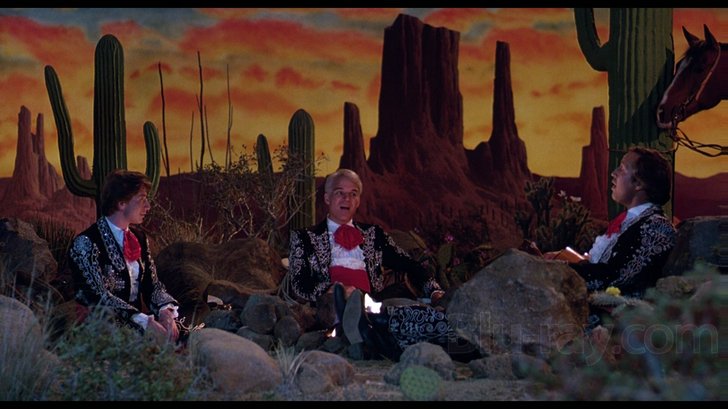
- Cast Interview (SD; 1.33:1; 5:39): According to the introductory text, this interview with the three stars was recorded in 1986 for promotional purposes, but it has not been restored or color corrected. This suggests that the EPK or other documentary for which the interview was intended was never completed. The interview was done after íThree Amigos! finished filming and the stars had moved on to other projects (Martin mentions Roxanne and Short refers to Innerspace), but they maintain the same easy rapport that prevailed during filming, and the interview is as worthwhile for observing their interaction as for its substance.
- Deleted Scenes (HD; 1.85:1; 19:05): Landis explains in introductory text that all the trims and deletions have been discarded. These scenes come from an "exhibitors' print" made before the final edit was locked. Landis was on trial in connection with deaths during the filming of The Twilight Zone movie during the editing of íThree Amigos!, and the studio, the now-defunct Orion Pictures, made additional changes to the film after Landis delivered his cut. One of these was the removal of a long sequence showing the Amigos in the studio mansion (from which they're evicted) and walking through the studio backlot on their way to the meeting with Flugleman. Another lengthy scene is an alternate title sequence set against El Guapo's initial raid on Santa Poco, which is not seen in the final film. Two additional short trims extend scenes that remain, one involving Dusty, the other involving El Guapo.
- íAmigos Reunited! (insert booklet): This article and interview first appeared in the June 2011 issue of Empire magazine. The director and three stars reassembled for a light-hearted and informative interview about the making of the film, its reception and its afterlife. Photographs, both vintage and contemporary, are included.
íThree Amigos! Blu-ray Movie, Overall Score and Recommendation 
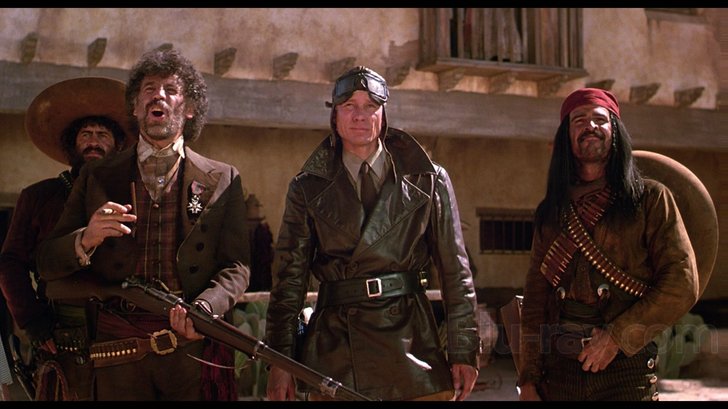
It would be tempting to call íThree Amigos! a cult classic, but as the Empire interview points out, the film has become more than that. The phrase has become part of sports culture, it's been used by political cartoonists, and it was referenced on an episode of The Sopranos. Even people who haven't seen the movie (or have only seen part of it) know about the three doofus movie stars with the strange salute who get mistaken for real-life heroes. At long last, there's a watchable (and affordable) version of the film that everyone can watch. For years, the Three Amigos refused to die like dogs, and now they can fight like lions. Highly recommended, even if you have a plethora of Blu-rays.
Similar titles
Similar titles you might also like

City Slickers
1991

Overboard
2018

Long Shot
2019

Parental Guidance
2012

The Twelve Chairs
1970

A Million Ways to Die in the West
2014

Snatched
2017

Accidental Love
2015

Rat Race
2001

Spaceballs 4K
1987

The Odd Couple II
Amazon Manufactured on Demand
1998

The Gods Must Be Crazy
1980

To Be or Not to Be
1983

Blazing Saddles
1974

Silent Movie
1976

See No Evil, Hear No Evil
1989

Dinner for Schmucks
2010

Dumb and Dumber
Unrated
1994

Shanghai Knights
2003

The Internship
2013
